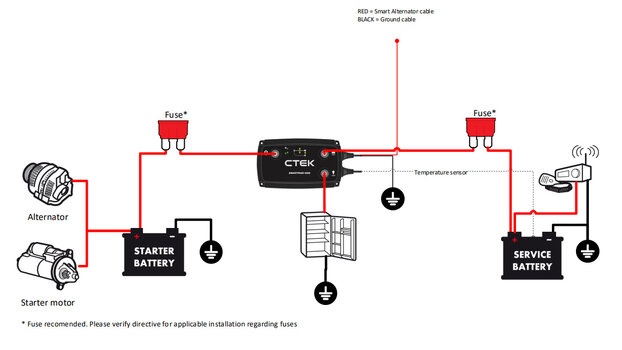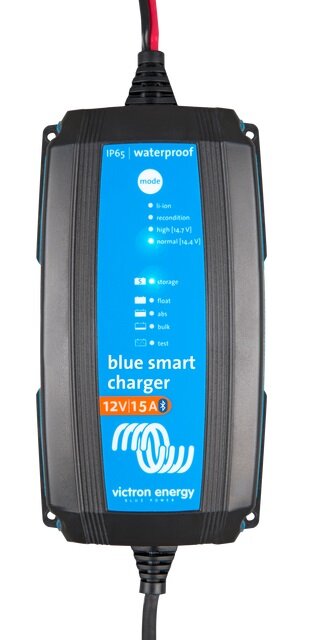The Grenadier Forum
Register a free account today to become a member! Once signed in, you'll be able to contribute to the community by adding your own topics, posts, and connect with other members through your own private inbox! INEOS Agents, Dealers or Commercial vendors please contact admin@theineosforum.com for a commercial account.
You are using an out of date browser. It may not display this or other websites correctly.
You should upgrade or use an alternative browser.
You should upgrade or use an alternative browser.
(The battery and monitor thread )Car dead in the middle of the woods
In the back of my mind I wonder what was done to maintain these batteries whilst some vehicles were in 'batch and hold' for so long? Mine was built in January and soon to arrive. Were the batteries disconnected, kept on a maintenance charge, let go flat with constant discharge, replaced? Who knows.. just have to wonder eh.I haven't driven the vehicle for a weekso I checked the voltage between the charging post and the closest earth: 12.5V or ~70%
I connected a new Victron 15Amp smart charger ...took about 1 hr 50 mins to register the "green light" float status. I let it settle then checked the voltage again after 10 mins with two different multimeters. One registered 12.59V, the other 12.60V. ...say about 80%. I would have expected higher. I didn't have time to check the battery status on the main display.
Upvote
0
My Grenny had around 83% SOC at pickup dealer, Matzker said the had not the time to charge.. ~8 week between production and delivery.
Upvote
0
Ok, your fridge is running off the starter battery as it supplies the 12V socket in the boot. If you aren't driving enough to recharge the starter each day, it starts to fall behind so each night you start with less & less capacity to run the fridge until eventually the starter gets so low in the morning it can't start the vehicle. The service battery would've been trickle charging the starter continuously across the Smartpass sensing it was low, but it's only designed to maintain a charged starter, it can't supply enough charge to keep up with the fridge load. I'd say it would've also lost ground overtime to the point where it was also depleted and wasn't able to assist the starter to turn the engine over. Short drives to the next camp doesn't work well when you're running a fridge.We been travelling with the Engel fridge running in tue boot for over three weeks now. Only other power consumption while camping was loading mobile devices from the sockets in feont of the back seats. We mainly stayed for one night per spot. Last night charge went down from 84% to only 75%. Temperatures at night time being between 5 and 15 degrees C all trip.
So, it's better to run the fridge off the Smartpass load terminal not the boot socket, see snapshot below. You can also add a Ctek 250SE DC charger to the Smartpass which will boost charge to the service battery and charge it faster and to 100% on longer drives. The Smartpass can't do this on its own.
The fridge will also run directly from the alternator while on the move leaving the 250SE & Smartpass to charge the service battery uninteruppted.
Engine time is key. If you sit for two nights you quickly start to fall behind and it becomes more & more difficult to catch up. You could also use a portable solar panel with the 250SE if camped up for a couple of days, you'd need a 200w panel to cover the usage. I have this one which is only 5kgs and 0.5M² when packed away. https://www.amazon.de/dp/B09N3N8VV6/?tag=globalgrena0b-20
Attachments
Last edited:
Upvote
0
Agree it should've rested around 12.7-12.8V, maybe it lost 0.1V over the cable and connections to the starter, although I imagine it's fairly hefty cable.I haven't driven the vehicle for a weekso I checked the voltage between the charging post and the closest earth: 12.5V or ~70%
I connected a new Victron 15Amp smart charger ...took about 1 hr 50 mins to register the "green light" float status. I let it settle then checked the voltage again after 10 mins with two different multimeters. One registered 12.59V, the other 12.60V. ...say about 80%. I would have expected higher. I didn't have time to check the battery status on the main display.
Did you notice if the Victron auto selected 14.7V or 14.4V bulk charge or did you select. These EFBs have similar charging parameters to AGMs so should be charged at 14.4V.
Be interesting to see what the Victron would do now if connected to the service battery or what voltage the service battery is now sitting at.
Upvote
0
Interesting on several (german) web article is written that EFB‘s should not charged in AGM Mode. Normal battery mode is the right one. Now I am confused what is right.. These EFBs have similar charging parameters to AGMs so should be charged at 14.4V.
Be interesting to see what the Victron would do now if connected to the service battery or what voltage the service battery is now sitting at.
Upvote
0
- Local time
- 11:45 AM
- Joined
- Jul 27, 2022
- Messages
- 6,005
Ok, your fridge is running off the starter battery as it supplies the 12V socket in the boot. If you aren't driving enough to recharge the starter each day, it starts to fall behind so each night you start with less & less capacity to run the fridge until eventually the starter gets so low in the morning it can't start the vehicle. The service battery would've been trickle charging the starter continuously across the Smartpass sensing it was low, but it's only designed to maintain a charged starter, it can't supply enough charge to keep up with the fridge load. I'd say it would've also lost ground overtime to the point where it was also depleted and wasn't able to assist the starter to turn the engine over. Short drives to the next camp doesn't work well when you're running a fridge.
So, it's better to run the fridge off the Smartpass load terminal not the boot socket
The Smartpass trickle charging the starter battery and supplying the fridge via the load terminal both have a 11.5v cutoff, so I can't see why one would be better than the other in terms of just the fridge load.
Upvote
0
Had a short drive this morning and my SOC was 79%. Connected my CTEK MS10 charger via a trailer socket charging point and left to charge all day. Charger indicated battery was fully charged, took the Greny for a drive and it showed SOC of 80% and after a few miles increased to 81%. I have an auxiliary battery, nothing connected to any sockets.
I’m starting to think the Greny SOC reading is either as accurate as some of the other sensors, or I now need to give the battery a float charge to exceed indicated 80% SOC.
I’m starting to think the Greny SOC reading is either as accurate as some of the other sensors, or I now need to give the battery a float charge to exceed indicated 80% SOC.
Upvote
0
I am hopeful that before December all of you lucky, intrepid souls who already have your Grenadiers will have this issue worked out. A few pages back, someone posted a link to Amazon having a discounted price on the 250SE, and I jumped. It arrived today. Incidentally, I was looking at solar panels and managed to catch a Renology 200W / 20A MPPT setup that had a couple of hours left on a countdown timer for 47% off. That'll be here tomorrow. Not really sure I need it per se, but I'll have it.
My vehicle electrical experience has been limited to installing aftermarket stereos / subs and amplifiers. The whole proposition of smart alternators and whether to hook up the CTEK connections (for that matter, where to even connect them?) honestly is above my comfort level.
Das mo, so sorry for your unfortunate situation, and I'm glad everything worked out ok. Thanks for this thread, though. It's been most educational, although a bit expensive .
.
My vehicle electrical experience has been limited to installing aftermarket stereos / subs and amplifiers. The whole proposition of smart alternators and whether to hook up the CTEK connections (for that matter, where to even connect them?) honestly is above my comfort level.
Das mo, so sorry for your unfortunate situation, and I'm glad everything worked out ok. Thanks for this thread, though. It's been most educational, although a bit expensive
Upvote
0
I'm not sure how well you should rely on the vehicles indication of SOC as being exactly accurate. How do they establish this? Is it simply via voltage or is there a shunt involved? Can it be reset? Noting that the battery when being tested is not in an open cell state so it's either charging or discharging and this will have some effect.Had a short drive this morning and my SOC was 79%. Connected my CTEK MS10 charger via a trailer socket charging point and left to charge all day. Charger indicated battery was fully charged, took the Greny for a drive and it showed SOC of 80% and after a few miles increased to 81%. I have an auxiliary battery, nothing connected to any sockets.
I’m starting to think the Greny SOC reading is either as accurate as some of the other sensors, or I now need to give the battery a float charge to exceed indicated 80% SOC.
Upvote
0
I mentioned somewhere previously that the % readout would only be a rough guide and to basically ignore it and just watch the voltage. If the % display wasn't there owners wouldn't be fretting over SOC, you'd only see voltage as with most vehicles, the average punter knows if they see 11.9V something's not right but when it's displaying +12.0V all is good. There has to be some sort of shunt (likely a basic one) near the battery to show that % reading but they never do a good job of calculating charge or discharge, the peukert exponent and charge efficiency factor settings are mostly a shot in the dark so overtime the battery monitor starts to 'drift' and tell lies. To fix, you need to periodically charge the battery with a 240V smart charger to float to reset (recalibrate) to 100%, another reason to regularly charge the battery with a good charger. Battery monitors like the Victron BMVs can auto reset or be done manually but some cheaper/basic shunts will only have an auto reset and no user interface.I'm not sure how well you should rely on the vehicles indication of SOC as being exactly accurate. How do they establish this? Is it simply via voltage or is there a shunt involved? Can it be reset? Noting that the battery when being tested is not in an open cell state so it's either charging or discharging and this will have some effect.
Upvote
0
The 'normal' battery mode on the Victron is 14.4V (bulk). This article talks about charging EFBs and AGMs, about half way down.Interesting on several (german) web article is written that EFB‘s should not charged in AGM Mode. Normal battery mode is the right one. Now I am confused what is right.
It's why I've asked DenisM what mode the Victron selected.
Attachments
Upvote
0
Not sure the trickle charging at 3 secs bursts could keep up with a fridge load overnight. I'd say it's really only designed to maintain a small (maybe 100-150mA, 3 - 4Ahrs/day) 'at rest' self-discharge on the starter when say the car sits unused for weeks at a time. The average 55L fridge would use around 20Ah overnight, so with losses ~24Ah needs to go back in.The Smartpass trickle charging the starter battery and supplying the fridge via the load terminal both have a 11.5v cutoff, so I can't see why one would be better than the other in terms of just the fridge load.
Upvote
0
"Curiouser and curiouser"Agree it should've rested around 12.7-12.8V, maybe it lost 0.1V over the cable and connections to the starter, although I imagine it's fairly hefty cable.
Did you notice if the Victron auto selected 14.7V or 14.4V bulk charge or did you select. These EFBs have similar charging parameters to AGMs so should be charged at 14.4V.
Be interesting to see what the Victron would do now if connected to the service battery or what voltage the service battery is now sitting at.
The Victron I have is the IP65 12V 20A as per the illustration.
It auto-selected "Normal" 14.4V so that's the charge rate I used.
Today I went back and put the multimeter probes on the charge post and
* the nearest earth (Turbo manifold) 12.38V.
* the lifting ring near the rear of the engine near the firewall... 12.38
* top of the metal part of the radiator 12.79/12.8V!!!
* Service battery (battery terminals) 12.54V
* Starter battery +ve terminal and the designated earth in the floor 12.38V!
The reading between the charge post and the top of the radiator is most interesting. I'm scratching my head as to "why is it so? " (apologies to the late Prof Julius Sumner-Miller!
EDIT: the thought occurred to me that the vacant space under the seats adjacent to the service battery is an ideal storage position for a decent set of jumper leads!!
Last edited:
Upvote
0
SorryMark, the smartpass will work with a smart alternator if it's connected properly with it's red wire connected to 12 volts as this shows the device a smart alternator is utilised. The red wire of the D250SE is used in the same way to tell it that a smart alternator is being used. When in combination can charge up to 140amps which is impressive. See below images for smart alternator cable.
See my thoughts here. https://www.theineosforum.com/threa...moving-the-batteries.12412649/post-1333201772
Upvote
0
I use one of those for my campers lithium batteries. Good quality bit of kit.The 'normal' battery mode on the Victron is 14.4V (bulk). This article talks about charging EFBs and AGMs, about half way down.
It's why I've asked DenisM what mode the Victron selected.
Upvote
0
Maybe you caught the service battery doing it's 3 second burst of trickle charging the starter, which would've been happening since the service battery's voltage is higher than the starter's.The reading between the charge post and the top of the radiator is most interesting
From 12.6V down to 12.38V overnight on the starter doesn't bode well in relation to parasitic loads while the vehicle is parked up. Have you got the Advanced alarm system?
I'd stick the charger back on for a good 8-10hrs and measure again. Maybe charge up the service battery directly first. That way you could check the battery % progress on the screen while charging it & then the starter to see what it's reading.
Upvote
0
Ah! Thank you Mark...Maybe you caught the service battery doing it's 3 second burst of trickle charging the starter, which would've been happening since the service battery's voltage is higher than the starter's.
From 12.6V down to 12.38V overnight on the starter doesn't bode well in relation to parasitic loads while the vehicle is parked up. Have you got the Advanced alarm system?
I'd stick the charger back on for a good 8-10hrs and measure again. Maybe charge up the service battery directly first. That way you could check the battery % progress on the screen while charging it & then the starter to see what it's reading.
I must be a bit slow! Hadn't thought about the 3 sec pulse charging..
Will charge the storage battery then keep the charger connected 8-10 hrs. to reach "storage level" . Trouble is, it's street parked at present until I can get some major works completed to strengthen the underpinnings of the suspended garage underfloor to take the extra weight of the Grenadier ... Yes, the Trialmaster is fitted with the advanced alarm system.
Upvote
0
Upvote
0
Shame they don't have an isolation switch like Mercedes have.View attachment 7821578I’ve just back in my Grenadier after 5days in a marina car park and my state of charge is 94%. That’s not too bad I think
Upvote
0
Do you recall what the level was when you parked it, and had you manually charged the battery beforehand?I’ve just back in my Grenadier after 5days in a marina car park and my state of charge is 94%. That’s not too bad I think
Upvote
0
Similar threads
- Replies
- 51
- Views
- 3K
- Replies
- 26
- Views
- 2K
- Replies
- 36
- Views
- 2K
- Replies
- 19
- Views
- 1K





